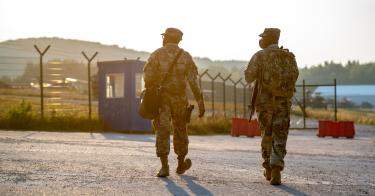The Pentagon decision to redeploy American troops stationed in Europe is about improving the conventional deterrence posture of NATO. Hats off to the Defense Department for thinking of how to make the best of the forces we have. Unfortunately, this action will not improve the overall deterrence posture of the United States, and it will come at some significant costs. It would be more effective and strategic to add to the rotational base and to deploy more forces for a forward presence. Simply moving troops around Europe creates more problems than it solves for the United States.
What this decision is not about is reducing our commitments to NATO. An index of military strength documents the reason for stronger conventional deterrence across Europe. Over the last four years, the administration has made significant gains in this regard and has pressed partner countries to do more. The United States has to build on this important success.
The administration has invested in our forces with demonstrable impact. Moreover, thanks in part to actions by the president, our allies have been investing more in defense. Last year marked the fifth consecutive year of growth in defense spending for Europe and Canada. As a result, NATO is now stronger today than it ever was under the last administration.
The United States has to continue to press allies to meet their obligations for collective defense. The investment by Germany remains low, but that is true of other NATO members, including countries slated to receive the redeployed American troops. It is critical to remember they are in Europe for national security interests. The presence of such forces contributes to the collective defense of the West. However, this is a consequence of, not the reason for, maintaining a robust presence across the continent.
This is why it makes sense for the Pentagon to think about how to get the most out of the forces at its disposal. Indeed, there are critical arguments for sending air assets south to bolster the southern flank. NATO definitely needs a stronger presence in the Black Sea and the Mediterranean Sea. In addition to conventional deterrence against Russia, such forces in Europe must also be properly situated if action is needed in the Middle East.
Having American forces in Europe that can respond rapidly to a range of contingencies, including those taking place in the Middle East and North Africa, reduces our risk. There are also some reasons to build a rotational presence in Europe. Having American forces that could deploy, train with allies, and swiftly relocate to wherever they might be needed most makes sense. But the Pentagon decision has raised some critical concerns.
First, moving the military outside of Germany is anything but a free lunch. There are significant costs attached with closing bases, relocating service members and their families, creating new facilities in places like Italy and Belgium, and sustaining a regular rotational presence within Europe from across the Atlantic Ocean. Finally, the money spent to make these moves is money that would not be available for other critical public needs.
Second, rotational forces do not substitute forward presence. The United States must provide both to Europe. The most likely aggression by Russia against NATO allies would be the “smash and grab” operation, a lightning strike in which Moscow seizes territory before the alliance can effectively respond. A robust forward presence reduces any risk that Vladimir Putin will think he can pull that kind of stunt and simply get away with it.
In shuffling troops out of Germany, the Pentagon is like a person who says, “I needed new tires so I purchased them with the money I meant to use to fix the brakes.” That will simply not cut it. It takes both to have a functional car. Conventional deterrence will need both rotational forces and forward presence. Congress has an important role here. It should be given the full strategic assessment over the value of forward deployed forces in Europe and the threats that could emerge if they are withdrawn. American troops must not move out of Germany until these concerns are answered.
This piece originally appeared in The Hill on 8/03/20




